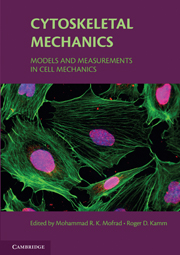Book contents
- Frontmatter
- Contents
- List of Contributors
- Preface
- 1 Introduction, with the biological basis for cell mechanics
- 2 Experimental measurements of intracellular mechanics
- 3 The cytoskeleton as a soft glassy material
- 4 Continuum elastic or viscoelastic models for the cell
- 5 Multiphasic models of cell mechanics
- 6 Models of cytoskeletal mechanics based on tensegrity
- 7 Cells, gels, and mechanics
- 8 Polymer-based models of cytoskeletal networks
- 9 Cell dynamics and the actin cytoskeleton
- 10 Active cellular protrusion: continuum theories and models
- 11 Summary
- Index
6 - Models of cytoskeletal mechanics based on tensegrity
Published online by Cambridge University Press: 10 November 2009
- Frontmatter
- Contents
- List of Contributors
- Preface
- 1 Introduction, with the biological basis for cell mechanics
- 2 Experimental measurements of intracellular mechanics
- 3 The cytoskeleton as a soft glassy material
- 4 Continuum elastic or viscoelastic models for the cell
- 5 Multiphasic models of cell mechanics
- 6 Models of cytoskeletal mechanics based on tensegrity
- 7 Cells, gels, and mechanics
- 8 Polymer-based models of cytoskeletal networks
- 9 Cell dynamics and the actin cytoskeleton
- 10 Active cellular protrusion: continuum theories and models
- 11 Summary
- Index
Summary
ABSTRACT: Cell shape is an important determinant of cell function and it provides a regulatory mechanism to the cell. The idea that cell contractile stress may determine cell shape stability came with the model that depicts the cell as tensed membrane that surrounds viscous cytoplasm. Ingber has further advanced this idea of the stabilizing role of the contractile stress. However, he has argued that tensed intracellular cytoskeletal lattice, rather than the cortical membrane, confirms shape stability to adherent cells. Ingber introduced a special class of tensed reticulated structures, known as tensegrity architecture, as a model of the cytoskeleton. Tensegrity architecture belongs to a class of stress-supported structures, all of which require preexisting tensile stress (“prestress”) in their cable-like structural members, even before application of external loading, in order to maintain their structural integrity. Ordinary elastic materials such as rubber, polymers, or metals, by contrast, require no such prestress. Ahallmark property that stems from this feature is that structural rigidity (stiffness) of the matrix is nearly proportional to the level of the prestress that it supports. As distinct from other stress-supported structures falling within the class, in tensegrity architecture the prestress in the cable network is balanced by compression of internal elements that are called struts. According to Ingber's cellular tensegrity model, cytoskeletal prestress in generated by the cell contractile machinery and by mechanical distension of the cell. This prestress is carried mainly by the cytoskeletal actin network, and is balanced partly by compression of microtubules and partly by traction at the extracellular adhesions.
- Type
- Chapter
- Information
- Cytoskeletal MechanicsModels and Measurements in Cell Mechanics, pp. 103 - 128Publisher: Cambridge University PressPrint publication year: 2006
- 6
- Cited by



